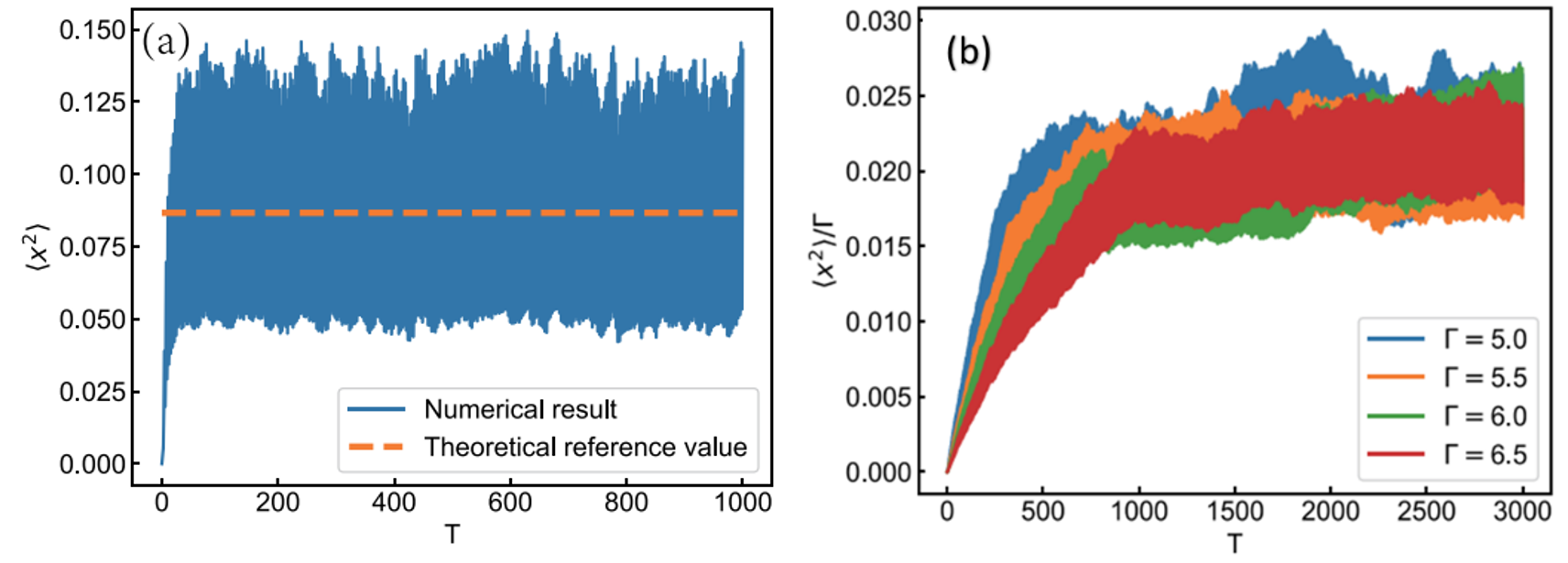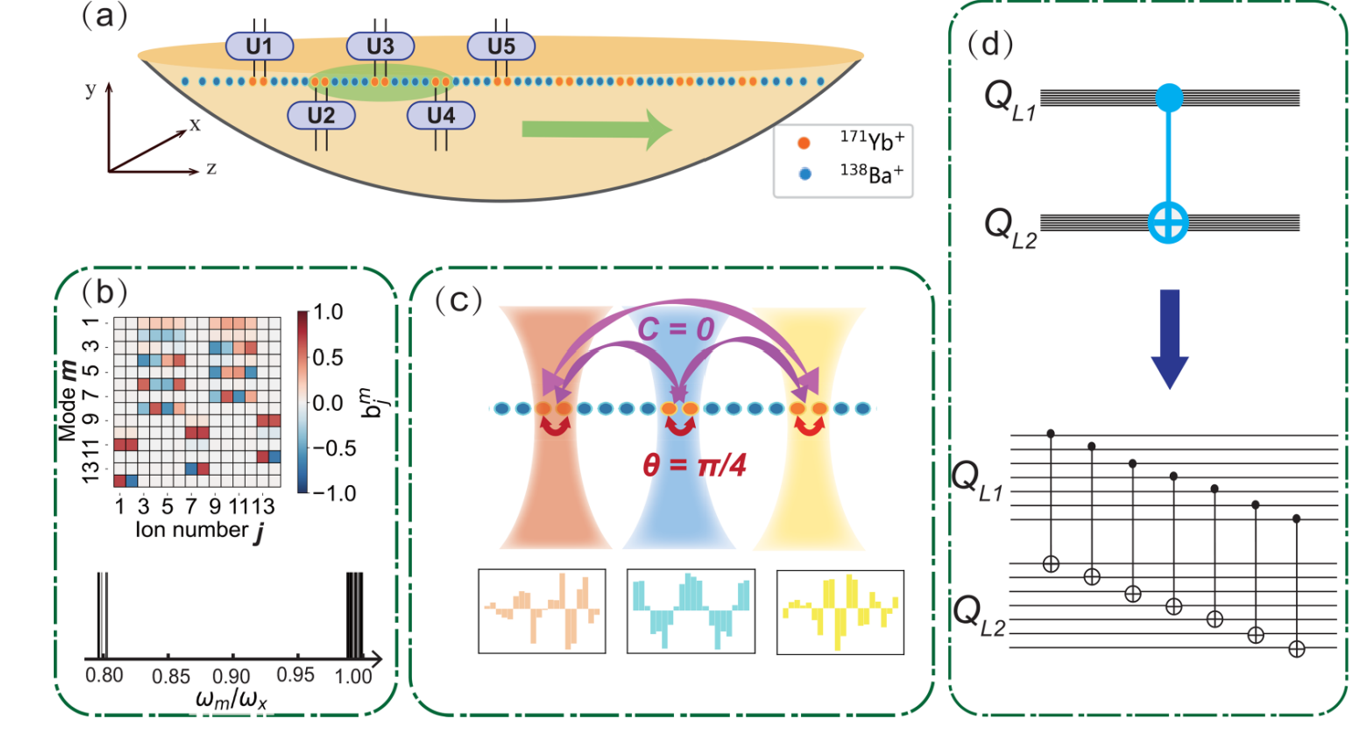Research progress on noise-resilient quantum gates in trapped-ion system
2023/11/08
Recently, a series of theoretical progress have been made in noise-resilient quantum gates with trapped ions by a team led by professor Liang-You Peng and CAS academician Qihuang Gong from Beijing Academy of Quantum Information Sciences and School of Physics at Peking University.
In the noisy intermediate-scale quantum (NISQ) era, it is increasingly important to understand and control the noise in the quantum information processing. Trapped in external electric fields, ions can serve as quantum bits, while the alternating electric field and the external noise can lead to micromotions of the ions, thus affecting the fidelity of the quantum gates. The team proposes a new recursive method, which greatly accelerates the numerical solution of the micromotions compared to the traditional method of solving a system of differential equations. Meanwhile, they derive an analytical formula describing the effect of the specific parameters of the colored noise on the ion micromotion (Fig. 1). These results can be used to explore the effect of specific noise in practice on the signal collecting and the gate fidelity, with efforts to eliminate the disturbance of the noise on quantum operations. This work has been published in the Journal of Physics A: Mathematical and Theoretical, 56, 465302 (2023), titled "Systematic investigations on ion dynamics with noises in Paul trap".

Fig. 1. The micromotion of the ion with the colored noise. (a) The simulated position of the ion and the theoretical mean value. (b) Our analytical derivation shows that the amplitude of the ion motion is proportional to the damping coefficient, which agrees with the results of numerical simulations.
The trapped-ion system is one of the most promising platforms for a large-scale, fault-tolerant quantum computing and quantum simulation due to many beneficial characteristics, such as the longest coherence time, and the high-fidelity single-qubit, two-qubit or multiqubit entangling gates. However, the critical issue is how to use lasers to realize fast and robust quantum gates with high fidelity and to realize fault-tolerant quantum computing. Based on the Molmer-Sorensen gates, the team improve the algorithms which can design amplitude modulation (AM) and phase modulation (PM) laser pulses with better performance to achieve a high fidelity whilst by robust laser pulses with the power and gradient optimization. These delicate considerations will play important roles in the experimental implementations.
In the experiment, one pulse scheme was proposed in which two qubits were entangled through the amplitude modulated pulses with many time segments. However, since one applies discrete AM pulses that are equally segmented in time, a large relative change of amplitudes in neighboring pulses is hard to be physically implemented, especially when one performs fast gates. To overcome this difficulty, the team propose a geometrical hypersurface-tangent method to optimize the laser power and the pulse gradient, carefully considering the experimental feasibility in realizing the effective Rabi frequency and its change between adjacent pulse segments on the basis of the high gate infidelity. In addition, their present scheme provides a unified framework to improve the robustness to an arbitrary order against random static drifts of the motional frequencies, the gate duration errors, the laser detuning drifts, and their simultaneous drifts. Finally, their method allows to optimize the solution for the case of a few segments by constructing an approximated null space through trading a negligible amount of gate fidelity This work was published in Physical Review A, 107, 042617 (2023) with the title “Robust segmented entangling gates with pulse gradient and power optimization using a hypersurface-tangent method”.
 Fig. 2. (a) The gradient-optimized pulse with amplitude-modulated scheme. (b) The resource consumption of the phase-modulated pulse.
Fig. 2. (a) The gradient-optimized pulse with amplitude-modulated scheme. (b) The resource consumption of the phase-modulated pulse.
The phase can be modulated in a faster time scale, which means that the distortion of the phase-modulated pulses is not a critical problem. However, it is difficult to find perfect solutions due to the issue of convergence for a large number of ions. The team propose an efficient numerical method without directly optimizing a cost function. Their main idea is to convert the complex function to the combination of linear algebra and the solution to quadratic equations, which greatly improve the convergence. Compared with previous methods, the maximum number of ions which can be solved for targeted pulses is doubled with the present algorithm. The work has been published in Physical Review E, 107, 035304 (2023) with the title of "Efficient numerical approach to high-fidelity phase-modulated gates in long chains of trapped ions ".

Fig. 3. The implementation of high-fidelity and low-crosstalk parallel two-qubit quantum gates. (a) The periodic 171Yb+ / 138Ba+ mixed species ion chain where 71Yb+ acts as computational qubits and 138Ba+ as ancillary qubits. (b) The localized transverse motional modes (top) and the gapped mode frequencies (bottom) of the shadowed subset in the chain. (c) The optimized results for the shadowed subset in the chain. (d) One of the possible applications for the logical CNOT gate with the Steane code in QEC.
The ability to perform entangling operations in parallel with low errors in a scalable fashion parallel entangling gates can provide significant improvement in quantum algorithms and quantum error-correction (QEC) circuits. However, for a long trapped-ion chain, the simultaneous implementation of two-qubit quantum gates is a challenging task due to the drastic increase of the crosstalk resulting from the progressively dense motional modes and complex experimental implementation conditions. In addition, it is almost impossible to find analytical solutions to this nonconvex quadratically constrained problem, which is NP hard in general. The numerical optimization techniques become inefficient and impractical with the nonlinear increase of the constraints for a long ion chain, due to the demanding computation resources, the loss of fidelity, and the increase of crosstalk, and the pulse complexity. The team utilize the localized motional modes and the gapped mode frequencies of the mixed-species ion chain to greatly simplify the constraints of gate and lower the crosstalk. More importantly, they have proposed a highly efficient iterative scheme to eliminate the crosstalk within the neighboring pairs and demonstrated its implementation for high-fidelity, low-crosstalk, scalable, and robust parallel two-qubit quantum gates in a long mixed-species chain. The iterative approach is scalable, which is also valid for an infinite long uniform ion chain. In the future, a combination of the present parallel gates with trapping and rearrangement of individual ions in a mixed-species chain may serve as an efficient scheme for error-corrected and fault-tolerant operations to eventually enable a large-scale trapped-ion quantum processor. The work was published in Physical Review A, 108, 042603 (2023), titled “High-quality parallel entangling gates in long mixed-species ion chains”.
These works have been supported by Beijing Academy of Quantum Information Sciences and by the National Natural Science Foundation of China (Grants No. 12234002 and No. 92250303).
Links to these publications:
https://iopscience.iop.org/article/10.1088/1751-8121/ad0348
https://journals.aps.org/pra/abstract/10.1103/PhysRevA.107.042617
https://journals.aps.org/pre/abstract/10.1103/PhysRevE.107.035304
https://journals.aps.org/pra/abstract/10.1103/PhysRevA.108.042603
 中文
中文 Email
Email QCloud
QCloud Log in
Log in
